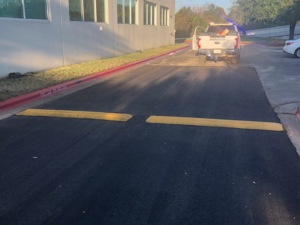 Whether you call them speed bumps or speed humps, these lumps in the pavement can enhance the safety of a parking lot, neighborhood, school zone, or playground by strongly encouraging drivers to slow down. However, the installation of a speed bump should begin with careful consideration of your reasons for choosing this traffic-calming measure so that you and your contractor can craft a detailed plan for the actual installation.
Whether you call them speed bumps or speed humps, these lumps in the pavement can enhance the safety of a parking lot, neighborhood, school zone, or playground by strongly encouraging drivers to slow down. However, the installation of a speed bump should begin with careful consideration of your reasons for choosing this traffic-calming measure so that you and your contractor can craft a detailed plan for the actual installation.
What Is the Best Approach for Speed Bump Installations?
Why Do the Reasons for Installing Speed Bumps Matter?
Obviously, you want drivers to slow down. However, you should dig a little deeper to determine why drivers need to reduce their speeds. Is your goal to reduce low-speed collisions between automobiles, or are you more concerned about the number of pedestrians being struck by vehicles? Do you need to maximize the protection of young children, bicyclists, disabled individuals, senior citizens, or other vulnerable groups? Are drivers racing through the route that pedestrians must follow to reach your entrance, or do you need to slow the approach to an intersection with a visual obstruction? Do you want drivers to be more aware of trucks that are entering and exiting your loading dock? Do you need to draw more attention to crosswalks, upcoming stop signs, or parks and playgrounds? Once you understand your needs, it will be easier for you to plan your speed bump installation.
Where Should I Place a Speed Bump?
Because there are specific guidelines and best practices for installing all types of traffic-calming measures, you should always seek the guidance of an experienced, reputable asphalt contractor. However, the following tips can serve as a preliminary guide if you are considering installing speed bumps.
• Speed bumps are meant to slow traffic, but they should not stop it. For example, a speed bump can slow the traffic approaching a crosswalk, but you should install a stop sign if you want cars to come to a complete halt.
• Your contractor can design speed humps that will not significantly impede fire trucks, buses, and other large vehicles. Most of these vehicles are wide enough to straddle a speed bump without driving across it. However, your contractor will need to evaluate the local ordinances and your desired goals before making a decision.
• A speed bump should never come as a surprise to a driver, pedestrian, or cyclist. Warning signs, eye-catching paint designs, and reflectors can help make speed humps more obvious.
• Speed humps are more suitable for parking lots, quiet residential streets, and apartment complexes than for busy thoroughfares. If the posted speed limit exceeds 35 mph, speed humps are generally a bad idea.
• A speed bump’s height and width are both critical factors that your contractor must consider. If drivers are operating their vehicles responsibly, the goal should be to slow them down without damaging their vehicles.
• If there are no curbs on your pavement, your contractor may need to take steps to prevent people from driving around the speed humps and damaging your landscaping.
Alpha Paving offers speed bump installation and many other paving services in the Austin metro areas. Our paving services include asphalt paving, parking lot striping, street maintenance, thermoplastic pavement markings, traffic sign installation, asphalt overlays, car stop installations, road construction, asphalt crack repairs, and asphalt milling. Our concrete services include concrete sidewalks, concrete parking lots, concrete ramps, concrete driveways, concrete curbing and ADA concrete. We have an unmatched reputation for quality, service, and professionalism. You can ask for a free quote by calling us in Round Rock at 512-677-9001 or submitting the online form.




